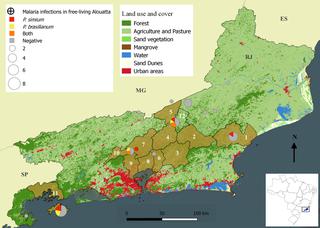当前位置:
X-MOL 学术
›
PLOS Negl. Trop. Dis.
›
论文详情
Our official English website, www.x-mol.net, welcomes your feedback! (Note: you will need to create a separate account there.)
Howler monkeys are the reservoir of malarial parasites causing zoonotic infections in the Atlantic forest of Rio de Janeiro.
PLOS Neglected Tropical Diseases ( IF 3.8 ) Pub Date : 2019-12-09 , DOI: 10.1371/journal.pntd.0007906 Filipe Vieira Santos de Abreu 1, 2 , Edmilson Dos Santos 3 , Aline Rosa Lavigne Mello 4, 5 , Larissa Rodrigues Gomes 4, 5 , Denise Anete Madureira de Alvarenga 6 , Marcelo Quintela Gomes 1 , Waldemir Paixão Vargas 7 , Cesare Bianco-Júnior 4 , Anielle de Pina-Costa 5, 8, 9 , Danilo Simonini Teixeira 10 , Alessandro Pecego Martins Romano 11 , Pedro Paulo de Abreu Manso 12 , Marcelo Pelajo-Machado 12 , Patrícia Brasil 5, 8 , Cláudio Tadeu Daniel-Ribeiro 4, 5 , Cristiana Ferreira Alves de Brito 6 , Maria de Fátima Ferreira-da-Cruz 4, 5 , Ricardo Lourenço-de-Oliveira 1, 5
PLOS Neglected Tropical Diseases ( IF 3.8 ) Pub Date : 2019-12-09 , DOI: 10.1371/journal.pntd.0007906 Filipe Vieira Santos de Abreu 1, 2 , Edmilson Dos Santos 3 , Aline Rosa Lavigne Mello 4, 5 , Larissa Rodrigues Gomes 4, 5 , Denise Anete Madureira de Alvarenga 6 , Marcelo Quintela Gomes 1 , Waldemir Paixão Vargas 7 , Cesare Bianco-Júnior 4 , Anielle de Pina-Costa 5, 8, 9 , Danilo Simonini Teixeira 10 , Alessandro Pecego Martins Romano 11 , Pedro Paulo de Abreu Manso 12 , Marcelo Pelajo-Machado 12 , Patrícia Brasil 5, 8 , Cláudio Tadeu Daniel-Ribeiro 4, 5 , Cristiana Ferreira Alves de Brito 6 , Maria de Fátima Ferreira-da-Cruz 4, 5 , Ricardo Lourenço-de-Oliveira 1, 5
Affiliation

|
BACKGROUND
Although malaria cases have substantially decreased in Southeast Brazil, a significant increase in the number of Plasmodium vivax-like autochthonous human cases has been reported in remote areas of the Atlantic Forest in the past few decades in Rio de Janeiro (RJ) state, including an outbreak during 2015-2016. The singular clinical and epidemiological aspects in several human cases, and collectively with molecular and genetic data, revealed that they were due to the non-human primate (NHP) parasite Plasmodium simium; however, the understanding of the autochthonous malarial epidemiology in Southeast Brazil can only be acquired by assessing the circulation of NHP Plasmodium in the foci and determining its hosts.
METHODOLOGY
A large sampling effort was carried out in the Atlantic forest of RJ and its bordering states (Minas Gerais, São Paulo, Espírito Santo) for collecting and examining free-living NHPs. Blood and/or viscera were analyzed for Plasmodium infections via molecular and microscopic techniques.
PRINCIPAL FINDINGS
In total, 146 NHPs of six species, from 30 counties in four states, were tested, of which majority were collected from RJ. Howler monkeys (Alouatta clamitans) were the only species found infected. In RJ, 26% of these monkeys tested positive, of which 17% were found to be infected with P. simium. Importantly, specific single nucleotide polymorphisms-the only available genetic markers that differentiate P. simium from P. vivax-were detected in all P. simium infected A. clamitans despite their geographical origin of malarial foci. Interestingly, 71% of P. simium infected NHPs were from the coastal slope of a mountain chain (Serra do Mar), where majority of the human cases were found. Plasmodium brasilianum/malariae was initially detected in 14% and 25% free-living howler monkeys in RJ and in the Espírito Santo (ES) state, respectively. Moreover, the malarial pigment was detected in the spleen fragments of 50% of a subsample comprising dead howler monkeys in both RJ and ES. All NHPs were negative for Plasmodium falciparum.
CONCLUSIONS/SIGNIFICANCE
Our data indicate that howler monkeys act as the main reservoir for the Atlantic forest human malarial parasites in RJ and other sites in Southeast Brazil and reinforce its zoonotic characteristics.
中文翻译:

ler猴是在里约热内卢大西洋森林中引起人畜共患病感染的疟原虫的宿主。
背景技术尽管巴西东南部的疟疾病例已大大减少,但过去几十年来,在里约热内卢州(RJ)大西洋沿岸偏远地区,间日疟原虫样本地人病例数据报告显着增加。在2015-2016年爆发。在几个人类病例中,仅在临床和流行病学方面,以及分子和遗传数据的共同揭示,它们是由于非人类灵长类动物(NHP)寄生虫疟原虫(Plasmodium simium)引起的。但是,只有通过评估病灶中NHP疟原虫的传播情况并确定其宿主,才能了解巴西东南部本地疟疾流行病学。方法学在RJ及其毗邻州的大西洋森林中进行了大量采样(米纳斯吉拉斯州(Minas Gerais),圣埃斯皮里图圣保罗),以收集和检查自由生活的NHP。通过分子和显微镜技术对血液和/或内脏进行了疟原虫感染分析。主要发现总共对来自四个州30个县的6种146种NHP进行了测试,其中大部分是从RJ收集的。ler猴(Alouatta clamitans)是唯一被发现感染的物种。在RJ中,这些猴子中有26%测试为阳性,其中17%被发现感染了simium P. simium。重要的是,尽管有疟原虫的地理起源,但在所有感染了P. simium的A. clamitan中都检测到了特定的单核苷酸多态性(将P. simax与间日疟原虫区别开的唯一可用的遗传标记)。有趣的是,71%的被simium simium感染的NHP来自山脉的沿海坡地(Serra do Mar),发现大多数人类病例的地方。最初在RJ和EspíritoSanto(ES)州分别在14%和25%的自由how叫猴子中检出了巴西疟原虫/疟疾。此外,在RJ和ES的50%的子样本的脾脏碎片中检测到了疟疾色素,该子样本包括死掉的吼猴。所有NHP对恶性疟原虫均为阴性。结论/意义我们的数据表明,ler猴是巴西RJ和其他东南部地区大西洋森林人类疟疾寄生虫的主要贮藏库,并增强了其人畜共患病特征。在RJ和ES中,在包含死comprising叫猴子的50%子样本的脾脏片段中检测到了疟疾色素。所有NHP对恶性疟原虫均为阴性。结论/意义我们的数据表明,ler猴是巴西RJ和其他东南部地区大西洋森林人类疟疾寄生虫的主要贮藏库,并增强了其人畜共患病特征。在RJ和ES中,在包含死comprising叫猴子的50%子样本的脾脏片段中检测到了疟疾色素。所有NHP对恶性疟原虫均为阴性。结论/意义我们的数据表明,ler猴是巴西RJ和其他东南部地区大西洋森林人类疟疾寄生虫的主要贮藏库,并增强了其人畜共患病特征。
更新日期:2019-12-11
中文翻译:

ler猴是在里约热内卢大西洋森林中引起人畜共患病感染的疟原虫的宿主。
背景技术尽管巴西东南部的疟疾病例已大大减少,但过去几十年来,在里约热内卢州(RJ)大西洋沿岸偏远地区,间日疟原虫样本地人病例数据报告显着增加。在2015-2016年爆发。在几个人类病例中,仅在临床和流行病学方面,以及分子和遗传数据的共同揭示,它们是由于非人类灵长类动物(NHP)寄生虫疟原虫(Plasmodium simium)引起的。但是,只有通过评估病灶中NHP疟原虫的传播情况并确定其宿主,才能了解巴西东南部本地疟疾流行病学。方法学在RJ及其毗邻州的大西洋森林中进行了大量采样(米纳斯吉拉斯州(Minas Gerais),圣埃斯皮里图圣保罗),以收集和检查自由生活的NHP。通过分子和显微镜技术对血液和/或内脏进行了疟原虫感染分析。主要发现总共对来自四个州30个县的6种146种NHP进行了测试,其中大部分是从RJ收集的。ler猴(Alouatta clamitans)是唯一被发现感染的物种。在RJ中,这些猴子中有26%测试为阳性,其中17%被发现感染了simium P. simium。重要的是,尽管有疟原虫的地理起源,但在所有感染了P. simium的A. clamitan中都检测到了特定的单核苷酸多态性(将P. simax与间日疟原虫区别开的唯一可用的遗传标记)。有趣的是,71%的被simium simium感染的NHP来自山脉的沿海坡地(Serra do Mar),发现大多数人类病例的地方。最初在RJ和EspíritoSanto(ES)州分别在14%和25%的自由how叫猴子中检出了巴西疟原虫/疟疾。此外,在RJ和ES的50%的子样本的脾脏碎片中检测到了疟疾色素,该子样本包括死掉的吼猴。所有NHP对恶性疟原虫均为阴性。结论/意义我们的数据表明,ler猴是巴西RJ和其他东南部地区大西洋森林人类疟疾寄生虫的主要贮藏库,并增强了其人畜共患病特征。在RJ和ES中,在包含死comprising叫猴子的50%子样本的脾脏片段中检测到了疟疾色素。所有NHP对恶性疟原虫均为阴性。结论/意义我们的数据表明,ler猴是巴西RJ和其他东南部地区大西洋森林人类疟疾寄生虫的主要贮藏库,并增强了其人畜共患病特征。在RJ和ES中,在包含死comprising叫猴子的50%子样本的脾脏片段中检测到了疟疾色素。所有NHP对恶性疟原虫均为阴性。结论/意义我们的数据表明,ler猴是巴西RJ和其他东南部地区大西洋森林人类疟疾寄生虫的主要贮藏库,并增强了其人畜共患病特征。



























 京公网安备 11010802027423号
京公网安备 11010802027423号